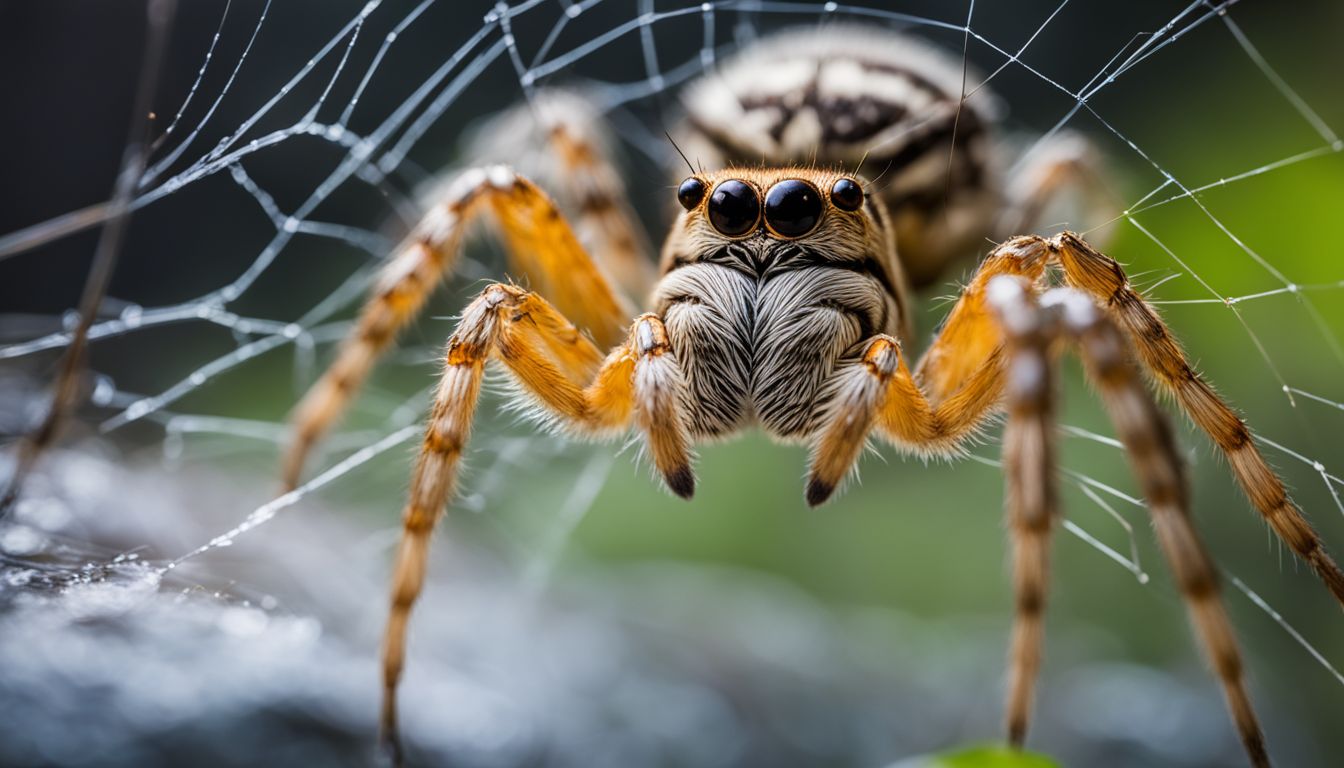Have you ever watched a spider scurry away after being gently nudged and wondered if it felt pain? Many people think that these eight-legged creatures can’t experience discomfort like we do.
Our blog post will unravel the mystery behind spiders’ reactions to injuries and what science says about their ability to feel pain. Read on, it’s going to get interesting!
Key Takeaways
- Spiders have nociceptors and a complex pain reception system, which suggests they may be capable of feeling pain in response to harmful stimuli.
- Observable behaviors such as protective motor reactions, autotomy, and post-injury changes indicate that spiders might experience distress or discomfort akin to pain.
- Ethical considerations are important when handling spiders, as emerging evidence challenges previous assumptions about their potential to feel suffering.
Understanding Pain in Biological Terms

Pain, in biological terms, is a complex sensory and emotional experience that serves as a protective mechanism to prevent harm. The pain reception system in spiders involves nociceptors and neural pathways that respond to harmful stimuli.
Defining Pain and Its Purpose
Pain tells us when something is not right with our bodies. It can be sharp or dull and comes from an injury, illness, or other harm. Living things have pain so they can react to danger and protect themselves.
For example, if you touch something hot, pain makes you pull away fast. This helps keep you safe from burns.
In spiders and other creatures, feeling pain might help them stay away from enemies or stop doing things that could hurt them. Scientists see pain as a sign of complex systems inside living beings that deal with threats.
Pain also teaches animals to avoid bad situations in the future because they remember it hurts. So even though we don’t like feeling pain, it has an important job to do in keeping all sorts of animals safer.
The Pain Reception System in Spiders
Spiders have a system that might let them feel pain. Their venom has stuff like biogenic amines and ATP, which can make prey hurt. This shows spiders could have nerves set up to sense pain.
Polyamines in their venom stop NMDA channels and mess with their prey’s nerves. So, spiders seem to use a fancy way of handling pain.
This complex system could mean they really do feel things when they get hurt or face danger. Next, we look into if science agrees on whether creatures like spiders truly experience pain.
The Scientific Debate on Invertebrate Pain

Some scientists argue that invertebrates, including spiders, do not have the necessary brain structures to experience pain, while others point to the presence of nociceptors and observable responses to harm as evidence of potential pain perception in these creatures.
This debate raises important ethical considerations when it comes to the treatment of spiders and other invertebrates.
Nociceptors and Pain Reception
Nociceptors are like tiny alarm bells in bodies that tell an animal when something is hurting it. These special pain receptors notice bad things like heat, cold, or pressure that could hurt.
When nociceptors get activated, they send signals up through nerves to the brain. The brain then feels this as pain.
Spiders have nociceptors too. They help spiders know if they’re in danger, like from hot surfaces or sharp objects. If a scientist pokes a spider’s leg with something hot or sharp, their nociceptors fire off messages to their nervous system.
We see this because the spider tries to get away or protect itself. But we aren’t sure if spiders feel pain the way humans do since their brains and nervous systems are very different from ours.
Observable Responses to Harm in Spiders
After understanding how spiders detect and process harmful stimuli through their nociceptive system, it’s interesting to explore the observable responses they exhibit when harmed. Spiders, like many invertebrates, display protective motor reactions when subjected to harm.
This can include reflexive behaviors like leg withdrawal or rapid movement away from a potential threat. Another intriguing response is autotomy, where spiders intentionally detach a leg or body part if it’s trapped or damaged, enabling them to escape from predators or hazardous situations.
Furthermore, post-injury changes in behavior have been noted in spiders. They may alter their web-building patterns or feeding habits after experiencing harm, indicating an adaptive response to mitigate further danger and maintain survival.
Behavioral Evidence of Pain in Spiders
Spiders display protective motor reactions and autotomy, which are observable responses to harm. Changes in behavior post-injury also provide insight into potential pain experiences in spiders.
Protective Motor Reactions and Autotomy
Spiders display protective motor reactions when they are in pain. These behaviors indicate that they might be experiencing some form of distress. Here are some specific behaviors that spiders exhibit when in pain:
- Reduced use of affected areas: Spiders tend to avoid using the parts of their body that are injured or causing them pain.
- Limping: Similar to how humans might limp when injured, spiders also show signs of physical discomfort by limping.
- Rubbing and holding: Spiders may rub or hold the affected area, suggesting that they are trying to alleviate their discomfort.
- Autotomy: In severe cases, spiders may intentionally detach or shed a limb as a defensive response to pain or injury.
Changes in Behavior Post-Injury
After protective motor reactions and autotomy, spiders exhibit distinct changes in their behavior following an injury. These changes can provide insights into how spiders may experience pain or distress. Here are several observable alterations in spider behavior post-injury:
- Altered Movement Patterns: Spiders may show changes in their usual movement, such as reduced activity or avoidance of certain movements that could exacerbate their injury.
- Aggressive Responses: Some spiders may display increased aggression, potentially indicating heightened sensitivity and defensive reactions to avoid further harm.
- Web Building Modifications: Injured spiders have been observed to alter their web-building behavior, suggesting adaptive responses to mitigate discomfort or physical limitations.
- Feeding Behavior Changes: After sustaining an injury, spiders may exhibit differences in their feeding habits, potentially indicative of discomfort or compromised hunting capabilities.
- Resting and Nesting Alterations: Injured spiders may modify their resting or nesting behaviors, possibly seeking seclusion or altering their nesting sites to alleviate discomfort.
Ethical Considerations in the Treatment of Spiders
It is important to consider the potential suffering of spiders when handling or treating them, especially in research or pest control. This involves acknowledging their ability to feel pain and making ethical decisions based on this understanding.
The Importance of Considering Potential Suffering
Considering the potential suffering of spiders and other invertebrates is important because ongoing research suggests that these creatures may have the capacity to feel pain. Some scientists argue for greater ethical consideration for these animals, as emerging evidence challenges previous assumptions about their ability to experience suffering.
As our understanding of pain in animals continues to evolve, it becomes crucial to consider the well-being of all living beings, including those traditionally thought not to be capable of feeling pain.
Moving on from this discussion, let’s delve into understanding how pain is perceived and processed by spiders in biological terms.
Conclusion
In conclusion, the question of whether spiders can feel pain remains a subject of ongoing research and debate in the scientific community. Spiders have a unique body structure and nervous system that may result in different responses to injury compared to more complex animals.
While entomologists believe that insects, including spiders, do not feel pain like humans do, there is still much to learn about how these fascinating creatures perceive and respond to physical harm.
Further studies will continue shedding light on this intriguing aspect of spider biology.
FAQs
1. Do spiders have a way to sense pain?
Yes, spiders have sensory receptors and nerves that can detect harm, which is like how humans use their senses to feel pain.
2. What happens when a spider feels something might hurt it?
When something hurts a spider or could hurt it, they might show changes in what they do or try to get away from the thing causing the harm.
3. Can spiders feel pain like we do emotionally?
Spiders don’t likely feel pain with emotions as we do since their brains are very different and don’t handle feelings like ours.
4. Why does my spider act differently after getting hurt?
Just like us, a spider may change its behavior if it’s been hurt; for example, it may move less or try to protect itself more.
5. Can science help us understand more about how spiders sense things that could be painful?
Scientists use tools and knowledge of nerve signals and spider anatomy to learn more about how these creatures react to things that cause them harm.
6. Are there any medicines that affect if a spider can sense pain?
In studies where special drugs used by humans were given to insects similar to spiders, these animals acted as if they were not sensing the harmful things anymore.




